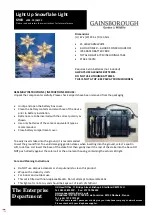
When making phase measurements, maintain a constant
amplitude point on the triggering signal so the two input signals are
compared indirectly to this reference, and directly to each other, The
trigger signal must have sufficient amplitude to ensure stable
triggering and be frequency related to the waveforms on which
phase measurements are to be made; however, the phase of the
trigger signal is not critical. It is essential that after triggering
conditions are established, there is no change during any phase
measurement.
The amplitude of the display should be large to improve
accuracy. Accuracy also depends upon keeping the waveforms
centered about the horizontal graticule centerline.
Phase comparison between two signals of the same frequency
can be made (up to the frequency limit of the vertical system) using
the dual-trace feature of the 212.
a. Set the VOLTS/DIV and VAR of both channels to display 4 or
5 divisions of vertical deflection.
b. Connect the reference signal to CH 2 and set the Triggering
SOURCE switch to CH 2, connect the signal to be compared
to the CH 1 probe tip.
c. Set the Triggering LEVEL/SLOPE for a stable display and set
the SEC/DIV switch to display about one cycle of signal.
Position the display to graticule center.
d. Turn the HORIZ MAG control until one cycle of the reference
signal {CH 2) occupies exactly 8 divisions horizontally. (See
Fig. 4.) Each division now represents 45° of the displayed
360° (eight divisions).
32
212 Operators Handbook


































